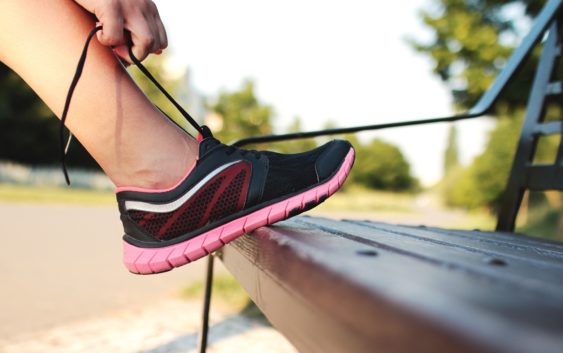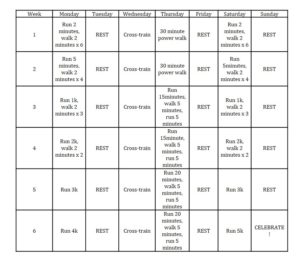Training for 5k

If you are reading this article then it is likely that you have decided that 2018 is the year for change! Congratulations and feel proud of yourself for making that decision.
Before you start any exercise plan it is advisable to consult your doctor especially if you have any existing medical conditions or you are concerned about your health.
What else do you need to consider?
- If your trainers are not designed for running it is important to visit a shop where you can have your gait analysed and buy the correct footwear. Also wearing running socks may reduce the risk of blisters. Incorrect footwear may cause problems with your muscles, joints and fascia.
- Invest in sensible clothing for all weather conditions. Layers are often most effective. Clothing is important but it does not necessarily have to be expensive running outfits. You just need something loose fitting and comfortable and women should consider a good sports bra for additional support.
- Plan and risk assess your route in advance. Always feel safe and within reach of help.
- Always carry your mobile phone with you in case of emergency.
Nutrition
Have you given any thought to nutrition? Food is fuel so if you choose wisely and make healthy food choices it will give your body the fuel it needs to sustain you during exercise. Below are a few eating and drinking tips for just before and after your run:
- Make sure you are hydrated before and after your training session.
- Eat at least 1 hour before you exercise. A light snack such as a banana is adequate.
- Generally, the body has enough stored carbohydrate (glycogen) to fuel 90 minutes of continuous exercise, but sports gels or sweets such as wine gums can provide a quick burst of energy as you run.
- Within 30 minutes of finishing a run, you need to replace lost energy and boost muscle repair – try a healthy snack bar or sports drink.
- Within 2 hours eat a meal – dishes rich in good carbohydrates and protein boost energy and repair – try a baked sweet potato with chicken, fish and vegetables, eggs (preferably not fried).
- Avoid caffeine and alcohol before and after your run – both can dehydrate you.
When you start your running program, a good running technique can help reduce your risk of injury and make your runs feel less tiring and more enjoyable.
Technique
Landing on the middle of your foot is the safest way to land. Use the whole of your foot including your toes and heels. Avoid striking the ground with your heel or your forefoot first. Your foot should land below your hips – not out in front of you. Aim for short light steps. Good running is light and quiet. Whatever your weight, your feet should not slap loudly as they hit the ground. Light steps are more efficient and cause less stress to the body.
Land with a slight bend in the knee. This helps to absorb the impact of running on hard surfaces. Don’t lift your knees too high and avoid bouncing up and down. Your knees should be lifting forwards rather than upwards.
Your hips should remain stable and forward-facing. Keeping this position in your hips can help prevent low back and hip pain. Don’t bend forward or backward from the waist as this places pressure on the hips. Imagine that you are running from just under your sternum (breastbone), which will help you stay tall.
Your arms should be bent at a 90-degree angle. Try to swing them forward and back, rather than across your body. The arm movement helps to propel you forward, so swinging them sideways is a waste of energy. Your arms are connected to your pelvis through fascia so using your arms correctly will help reduce tension further down your body!
Your hands should be relaxed, but don’t let them flop. Tight hands can cause tension all the way up to the back and shoulders.
Your shoulders should be back and down towards your pelvis. Keep them relaxed and avoid tensing them. Hunching your shoulders forward restricts breathing, allowing less oxygen to get to the muscles.
Keep your eye gaze ahead of you – about 30 to 40 metres is a good target. Avoid looking down at your feet. Looking down will create tension in your neck and shoulders. Keep your jaw and neck relaxed.
Whether you breathe through your nose or mouth, try to breathe deeply and rhythmically. Avoid shallow and quick breaths. Try to aim for one breath for every two strides, but don’t be afraid to try longer breathing.
Warm Up
Remember to warm up before each workout session. It can be tempting to close your front door and start running but this may result in injuries! A 10-minute brisk walk before you start the 5k program is probably sufficient.
Generally speaking, a dynamic warm-up is advisable to increase your heart rate in preparation for exercise and also to warm up your muscles, although some fitness professionals are not convinced this is necessary or even beneficial.
Adding a Pilates class to your training schedule will help you master your breathing technique.
Now you are ready to start. Here are some warm-up exercises that you may choose to do.
Dynamic warm up:
After your 10-minute walk add the dynamic exercises gradually increasing intensity.
Knee Highs
Gets the heart rate up, activates hip flexors and calves and warms up the upper body. Lift your knees and opposite arms up for 20 reps.
Butt Kicks
Loosens the quadriceps muscles at the front of your thighs and prepares your hamstrings (at the back of your thighs) for the landing motion. Jog slowly, kicking back with the trailing leg aiming for your gluteals (butt) for 20 reps.
Small Walking Lunges
Warms up the hip flexors, switches on the gluteals and raises the heart rate. From standing position, take a large step forward with your right leg and bend both knees so your front knee is in line with your ankle and your back knee is as close as possible to the floor. Do this without compromising your posture, and ensuring your back heel is lifted. Continue alternating legs for 10 reps on each leg.
Calf Step-Backs
A whole body exercise that switches on your core and stretches the calves and hip flexors. Starting with your feet together, step your right leg behind you (as you do when stretching your calf before and after each session) allowing both knees to bend slightly, raising your arms to shoulder height (avoid over extending your spine). Return to standing and repeat of the other leg. Perform 10 reps on each leg.
Toe Touches
Great for warming up your gluteals, lower back and abdominals. Standing on your left leg, bring your right knee up towards your chest and your right foot across the front of your left thigh. Bring your left hand to touch your right foot. Return to standing position and repeat on the other side. Perform 10 reps on each leg.
Hip Roll
Activates your pelvic area and engages your lower body. Stand with your feet hip-width apart, hands on hips and knees slightly bent to allow your pelvis to move freely. Make a large clockwise circle with your hips 10 times. Change direction for 10 times.
It is important to think about your technique as you start running to avoid injuries. Below are a few tips to get you started.
Look straight ahead and not at your feet! Looking down may create stress in your neck and shoulders. Try and keep your shoulders relaxed to enable you to breathe more easily. Arms and hands should be relaxed with your arms at a 45 degree angle. Try and stay in an upright tall position with your hips facing forward – this will help prevent lower back pain. Avoid striking the ground too heavy, rolling through the whole of your whole feet. Finally, try to breathe deeply and rhythmically avoiding shallow and quick breaths.
Now you are ready to start your 5k program.

It is important to stretch after you run. If you choose not to do this you may find that your muscles ache during the next few days. At this point it is a good idea to put on another layer of clothing to avoid your body temperature dropping too quickly.
Hold each stretch for between 30 and 40 seconds but hold the stretch for longer if you need too. Also be aware that different sides of your body may feel different. If you notice that one side feels tighter then hold the stretch for a little longer.
Post exercise stretches:
Kneeling Stretch
Stretches your hip flexors and core. If hip flexors are tight they will pull you off balance and your pelvis out of alignment. Kneel on a padded surface, lunge forward with your left knee, keeping it in line with your ankle. Place your hands on your hips and push your hips forward until you feel the stretch. Repeat on the other side.
Calf Stretch
This helps to keeps the calves loose and relieves stress in your Achilles. Stand with both feet hip width apart and place one foot behind you ensuring that both feet are straight and facing forward. Keep the front knee bent. Repeat on the other side.
Adductor Stretch (inner thigh)
Sit on the floor with your spine tall and place the soles of your feet together. Grasp your ankles and place your elbows just above your knees pushing down towards the floor. Hold the stretch don’t bounce!
Hamstring Stretch
Extend one leg in front of you with your heel on the floor, toes lifted. Hitch forward from the waist keeping your head above your heart until you feel a stretch along the back of your thigh. Ensure your spine stays long and shoulders relaxed.
Quadriceps Stretch
Elongates the muscles at the front of your thighs. Standing tall, lift one foot off the floor grasping your ankle with your hand behind you. Pull your foot up keeping your knees together and ensuring you don’t arch your back.
Well done for completing your run. Notice how good you feel and stay motivated for day 2.
